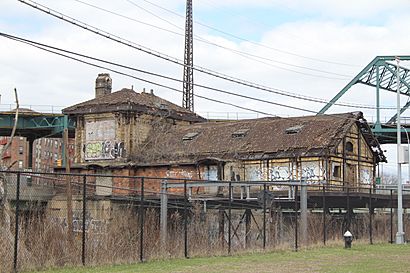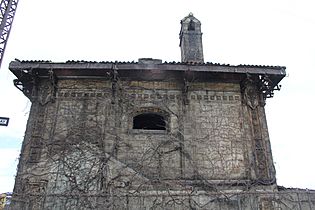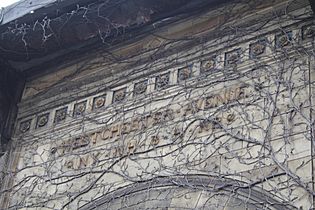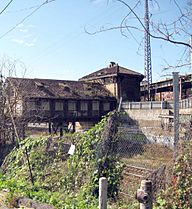Westchester Avenue station facts for kids
Quick facts for kids
Westchester Avenue
|
|||||||||||
|---|---|---|---|---|---|---|---|---|---|---|---|

Seen from the southeast showing waiting room section suspended over tracks
|
|||||||||||
| Location | Near southeast corner of Westchester Avenue and Sheridan Expressway, Bronx, New York, United States | ||||||||||
| Coordinates | 40°49′40″N 73°53′08″W / 40.827660°N 73.885417°W | ||||||||||
| Owned by | Amtrak | ||||||||||
| Construction | |||||||||||
| Architect | Cass Gilbert | ||||||||||
| History | |||||||||||
| Opened | 1908 | ||||||||||
| Former services | |||||||||||
|
|||||||||||
The Westchester Avenue station is an old, abandoned train station in the Bronx, New York City. It hangs partly over Amtrak train tracks, which are very busy. The station was built in 1908. It has beautiful details made from a special kind of clay called terra cotta.
A famous architect named Cass Gilbert designed the station. He also designed the Woolworth Building, which is a very tall skyscraper. Trains stopped using the Westchester Avenue station in 1937. Today, the station is a ruin and is in bad shape.
The station is near where Westchester Avenue and the Sheridan Expressway meet. It's in an area of the Bronx called Morrisania. The Bronx River is also very close by. The station has two main parts. One part is a taller entry hall that stands on solid ground. The other part is a waiting room that hangs over the train tracks. This part is held up by strong metal beams.
Long ago, there were stairs from the waiting room down to the train platforms. But these stairs are gone now. The entry hall has colorful terra cotta decorations. One decoration looks like a caduceus, which is a symbol with two snakes wrapped around a staff. This symbol was used by the New York, Westchester and Boston Railway, one of the train companies that used the station.
History of the Westchester Avenue Station
The Westchester Avenue station was built in 1908. It was part of a project by the New York, New Haven and Hartford Railroad. This company wanted to expand its train line into New York City. They planned to build twelve new stations for people who traveled short distances, called commuters.
The railroad asked architect Cass Gilbert to design these stations. Gilbert was already famous for designing the Alexander Hamilton U.S. Custom House in Lower Manhattan. He created different designs for each station. For Westchester Avenue, he chose a rich design with glazed terra cotta and gold-colored letters. Gilbert later used similar terra cotta details in his design for the Woolworth Building, which was finished in 1913.
The train line became very busy with long-distance trains. Today, it is part of the Northeast Corridor, which connects Boston, Massachusetts and Washington, D.C.. However, not many local people used the stations. This was especially true after the New York City Subway expanded in 1920. The subway only cost five cents, which was much cheaper.
Because of this, the local train stations became too expensive to keep open. The New Haven trains stopped serving Westchester Avenue in 1931. All the local stations were finally closed when the New York, Westchester and Boston Railway stopped running in 1937.
Future Plans for the Station
By 2009, the Westchester Avenue station was falling apart. It was in danger of collapsing. There were three other stations in the Bronx designed by Cass Gilbert. One of them, the Bartow/City Island Station, was also abandoned. The other two, Morris Park and Hunts Point, are now used for other things.
Amtrak owns the Westchester Avenue station. They have said it needs to be torn down. However, a group called the New York Landmarks Conservancy wants to save it. They have put the station on their list of important buildings that are in danger. But no government group has officially protected the station. It is not a designated New York City landmark. It is also not on the National Register of Historic Places.
Over the years, there have been ideas to fix and reuse the station. In 2011, two architects, Amanda Schachter and Alexander Levi, got money to create a new plan. They shared their idea in 2012. Their plan would split the station into two parts. The tall entry hall would stay where it is. It would become an entrance to Concrete Plant Park and the Bronx River Greenway.
The waiting room part, which hangs over the tracks, would be moved. It would be rebuilt nearby on a pier in the Bronx River. This plan got some attention, but no money has been found to make it happen yet. In 2015, this plan became part of the larger Bronx River Greenway extension project.
Gallery
See also
 In Spanish: Westchester Avenue (estación de tren) para niños
In Spanish: Westchester Avenue (estación de tren) para niños





